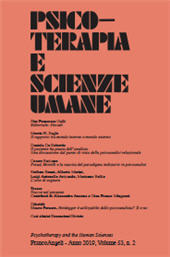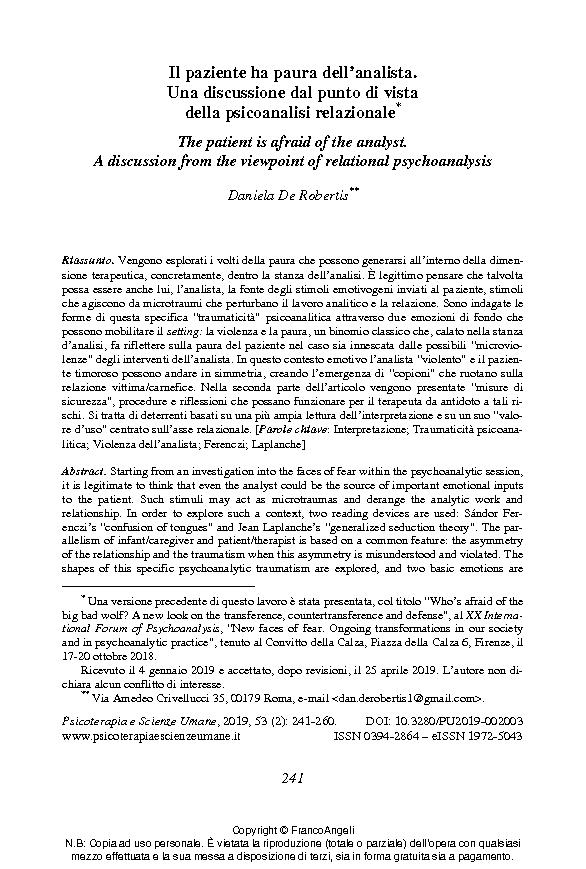Il paziente ha paura dell'analista : una discussione dal punto di vista della psicoanalisi relazionale
241-260 p.
Vengono esplorati i volti della paura che possono generarsi all'interno della dimensione terapeutica, concretamente, dentro la stanza dell'analisi. È legittimo pensare che talvolta possa essere anche lui, l'analista, la fonte degli stimoli emotivogeni inviati al paziente, stimoli che agiscono da microtraumi che perturbano il lavoro analitico e la relazione. Sono indagate le forme di questa specifica "traumaticità" psicoanalitica attraverso due emozioni di fondo che possono mobilitare il setting: la violenza e la paura, un binomio classico che, calato nella stanza d'analisi, fa riflettere sulla paura del paziente nel caso sia innescata dalle possibili "microviolenze" degli interventi dell'analista.
In questo contesto emotivo l'analista "violento" e il paziente timoroso possono andare in simmetria, creando l'emergenza di "copioni" che ruotano sulla relazione vittima/carnefice. Nella seconda parte dell'articolo vengono presentate "misure di sicurezza", procedure e riflessioni che possano funzionare per il terapeuta da antidoto a tali rischi. Si tratta di deterrenti basati su una più ampia lettura dell'interpretazione e su un suo "valore d'uso centrato sull'asse relazionale. [Testo dell'editore]
Starting from an investigation into the faces of fear within the psychoanalytic session, it is legitimate to think that even the analyst could be the source of important emotional inputs to the patient. Such stimuli may act as microtraumas and derange the analytic work and relationship. In order to explore such a context, two reading devices are used: Sándor Ferenczi's "confusion of tongues" and Jean Laplanche's "generalized seduction theory". The parallelism of infant/caregiver and patient/therapist is based on a common feature: the asymmetry of the relationship and the traumatism when this asymmetry is misunderstood and violated. The shapes of this specific psychoanalytic traumatism are explored, and two basic emotions are analyzed: violence and fear.
In the consulting room this combination refers to the patient's fear of the "violence" of analytic interpretations. It is an emotional context where a "violent" analyst and a fearful patient can have symmetrical roles and give origin to "victim/perpetrator" scripts. In the second part of the paper some "safety measures" and thoughts to limit these risks are suggested. The deterrent effects are based on a more complex look and on a more extensive relational use of interpretative "devices". The importance of interpretation as a password to enter into unconscious implicit configurations and semantic networks of the patient's narratives is discussed. Nevertheless it is essential to contextualize the interpretation to the patient's characteristics and to the therapeutic situation and process. [Publisher's text]
Is part of
Psicoterapia e scienze umane : LIII, 2, 2019-
Articles from the same issue (available individually)
-
Information
ISSN: 1972-5043
KEYWORDS
- Interpretazione, Traumaticità psicoanalitica, Violenza dell'analista, Ferenczi, Laplanche
- Interpretation, Psychoanalytic traumatism, Analiyst violence, Ferenczi, Laplanche



